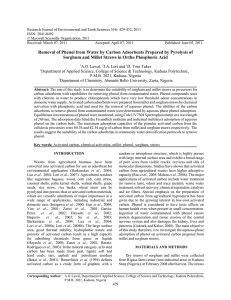Production of Activated Carbon by Chemical Treatment and the
advertisement
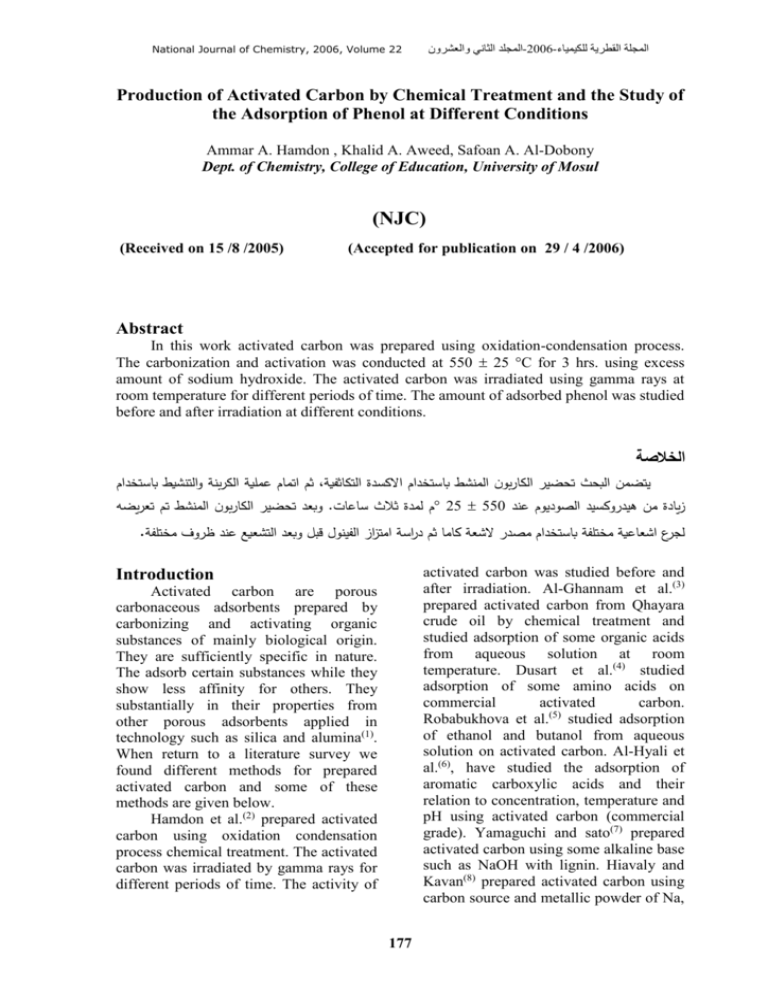
المجلد الثاني والعشرون-2006-المجلة القطرية للكيمياء National Journal of Chemistry, 2006, Volume 22 Production of Activated Carbon by Chemical Treatment and the Study of the Adsorption of Phenol at Different Conditions Ammar A. Hamdon , Khalid A. Aweed, Safoan A. Al-Dobony Dept. of Chemistry, College of Education, University of Mosul (NJC) (Received on 15 /8 /2005) (Accepted for publication on 29 / 4 /2006) Abstract In this work activated carbon was prepared using oxidation-condensation process. The carbonization and activation was conducted at 550 25 C for 3 hrs. using excess amount of sodium hydroxide. The activated carbon was irradiated using gamma rays at room temperature for different periods of time. The amount of adsorbed phenol was studied before and after irradiation at different conditions. الخالصة ثم اتمام عملية الكربنة والتنشيط باستخدام،يتضمن البحث تحضير الكاربون المنشط باستخدام االكسدة التكاثفية وبعد تحضير الكاربون المنشط تم تعريضه.م لمدة ثالث ساعات 25 550 زيادة من هيدروكسيد الصوديوم عند .لجرع اشعاعية مختلفة باستخدام مصدر الشعة كاما ثم دراسة امتزاز الفينول قبل وبعد التشعيع عند ظروف مختلفة activated carbon was studied before and after irradiation. Al-Ghannam et al.(3) prepared activated carbon from Qhayara crude oil by chemical treatment and studied adsorption of some organic acids from aqueous solution at room temperature. Dusart et al.(4) studied adsorption of some amino acids on commercial activated carbon. (5) Robabukhova et al. studied adsorption of ethanol and butanol from aqueous solution on activated carbon. Al-Hyali et al.(6), have studied the adsorption of aromatic carboxylic acids and their relation to concentration, temperature and pH using activated carbon (commercial grade). Yamaguchi and sato(7) prepared activated carbon using some alkaline base such as NaOH with lignin. Hiavaly and Kavan(8) prepared activated carbon using carbon source and metallic powder of Na, Introduction Activated carbon are porous carbonaceous adsorbents prepared by carbonizing and activating organic substances of mainly biological origin. They are sufficiently specific in nature. The adsorb certain substances while they show less affinity for others. They substantially in their properties from other porous adsorbents applied in technology such as silica and alumina(1). When return to a literature survey we found different methods for prepared activated carbon and some of these methods are given below. Hamdon et al.(2) prepared activated carbon using oxidation condensation process chemical treatment. The activated carbon was irradiated by gamma rays for different periods of time. The activity of 177 National Journal of Chemistry, 2006, Volume 22 Li and K carbonization of brown coal using hydroxide of Na and K at 500-700 C was carried out by Kobayashi and et al.(9). The present work involves the production of new activated carbon and studying its efficiency of adsorption phenol at various conditions before and after irradiation with gamma rays. المجلد الثاني والعشرون-2006-المجلة القطرية للكيمياء give rise to forces of attraction, called “Vander Wall’s forces”. Theses forces are responsible for the fact that gas or liquid molecules are enriched from the neighbourhood of the activated carbon and stored on the internal surface. This enrichment of gases or liquids is designated as adsorption. Adsorption is an equilibrium reaction whereby loading of adsorbent depends on concentration of liquid pressure of the adsorbate. The curve of the static equilibrium at constant temperature is called an “Adsorption Isotherm”. The results of the study are given in the Tables (1,2 and 3). Physical adsorption (of phenol) is readily decreased by lowering its concentration. The extent of adsorption depends greatly on the specific nature of the solid and of the molecules being adsorbed and is a function of concentration and temperature. From Freundlich equation: x KC n m where: x is the amount adsorbed on mass (m) of adsorbent, K and n are constants which can be determined using log-log plot, since: x log log K n log C m So that n is the slope of the line and K is the antilogarithum of the intercept. According to the Freundlich equation the amount adsorbent increases indefinitely with increasing concentration or pressure. When the adsorption of various gases or liquids are compared above their critical temperature, it is generally found that the amount adsorbed is smaller at the lower critical temperature (the critical temperature of a pure liquid is the highest temperature at which gas and liquid phase can exit as separate phase)(12). Table (2) shows that the amount adsorbed decreases when activated carbon was irradiated at room temperature using gamma rays for different periods of time. Gamma rays Experimental 1. Preparation of activated carbon: A known weight of asphaltic material was treated with (2% wt/wt) of FeCl3 in the presence of a stream of air at 350 C for 3 hrs. The oxidized material was treated with excess amount of sodium hydroxide [(1:2) (raw material:NaOH)] at 550 25 C for 3 hrs. The product of activated carbon was purified by treatment with 10% HCl under reflux for 1 hr. and washed by distilled water till it gives neutral test to litmus paper. 2. Adsorption of phenol from aqueous solution: One gram of activated carbon was added to 50 ml of phenol [concentrations are: 0.02, 0.03, 0.04 and 0.05 N]. The mixture was shaked vigorously for 1 hr. at room temperature. Then the mixture was filtered and 20 ml of the filtrate was titrated with 0.01 N sodium hydroxide and the adsorbed amount of phenol was calculated(10,11). The procedure was repeated under different temperatures and pH values. 3. Activated carbon irradiation: Activated carbon was irradiated using gamma rays from [cobalt-60-in University of Mosul-College of Science], for different periods of time. The adsorbed amount of phenol was calculated as in the step (2). Results and Discussion Carbon atoms located on the internal surface of the porous granules 178 National Journal of Chemistry, 2006, Volume 22 may be led to destroy some porous of activated carbon and this increases with increasing time of irradiation(2). However, the amount adsorbed increases slightly with increasing concentration, but vigorously decreases with increasing temperature. المجلد الثاني والعشرون-2006-المجلة القطرية للكيمياء Table (3) shows that the results indicated that the free phenol form in all cases is the most preferable form [phenol is transferred to phenoxide with increasing pH and then the amount of adsorbed phenol is decreased]. Table (1): Effect of temperature on adsorption of phenol on activated carbon at different concentrations Sample Temp. % of phenol at concentration (N) 0.02 0.03 0.04 0.05 (C) 1 15 7.300 8.500 8.900 9.700 2 20 6.500 7.900 8.100 8.201 3 30 5.100 7.100 8.001 8.201 Table (2): Effect of temperature and concentration on adsorption of phenol on irradiation activated carbon Sample Temp. Time of irradiation % of phenol at concentration (N) (min) 0.02 0.03 0.04 0.05 (C) 4 15 15 7.100 7.301 7.400 7.41 5 15 30 6.001 6.402 6.521 6.700 6 15 60 5.002 5.201 5.221 5.220 7 20 15 6.001 6.211 6.232 6.331 8 20 30 5.003 5.210 5.221 5.231 9 20 60 4.001 4.101 4.221 4.224 10 30 15 3.671 3.671 3.771 3.811 11 30 30 3.001 3.211 3.612 3.622 12 30 60 2.500 2.610 2.611 2.611 Table (3): Effect of pH on adsorption of phenol on activated carbon when other parameters are constant (concentration = 0.05 N, Temp. = 15 C) Sample Temp. Time of irradiation % of adsorption at pH (min) Natural 7 9 (C) 1 15 0 9.700 5.621 3.862 13 15 15 7.000 5.121 2.221 14 15 30 5.561 5.221 1.919 15 15 30 3.210 2.021 1.781 2.Hamdon, A.A., Aweed, K.A. and Al-Dubony, S.A., J. Educ. and References Sci,2005,Vol.17(2),12. 1.Aweed, K.A., “Study the effect 3.Al-Ghannam, K.A., Al-Naeme, K. of structural modifications on the and Hamdon, A.A., J. Educ. and production of the activated carbon Sci., 16, 3, 15, 2004. from heavy crude oil residues by 4.Dusart, O., Bouabane, H. and chemical treatment”, Ph.D. Thesis, Mozet, M., J. Chimie Physique University of Mosul, 2003. Etde. Physico-Chimie Biologique, 88, 2, 252, 1991. 179 National Journal of Chemistry, 2006, Volume 22 5.Ryabukhova, V.O., Arzamaa, S., Okishevana, A.B. and Konovalova, S.N., Russian J. of Physical Chemistry, 74, 2, 281, 2000. 6.Al-Hyali, A.A., Ramadhan, O.M. and Al-Dubony, S.A., J. Rafiden Science, Accepted for Publication, 2004. 7.Yamaguchi, T. and Sato, Y., Nippon Kogoku Kaishi, Iss. 3, 27, 1993. 8.Hiavaly, J. and Kavan, L., J. Carbon, 37, 1029, 1999. 9.Kobayashi, S. and et al., Nippon Kogoku Kaishi, Iss. 5, 329, 2000. 10. Daneils, F., Mathews, J.M., Williams, J.W., Bender, P., Alberty, R.A. and Corknwell, C.D., “Experimental Physical Chemistry”, McGraw-Hill Company, 1981. 11. Afzal, M. and Nasser, A., Pakistan, J. Sci. Ind. Res., 15, 3, 137, 1972. 12. Saleh, J.M., “Chemistry of Surfaces and Catalysts”, Baghdad University, 1980. 180 المجلد الثاني والعشرون-2006-المجلة القطرية للكيمياء
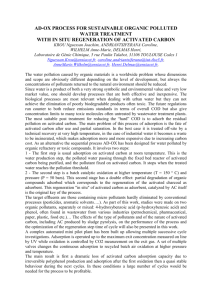
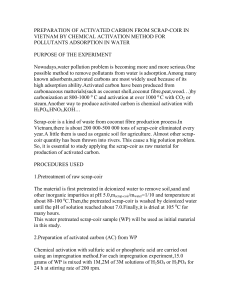
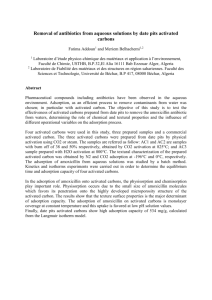
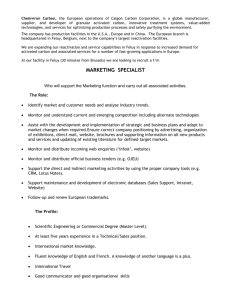



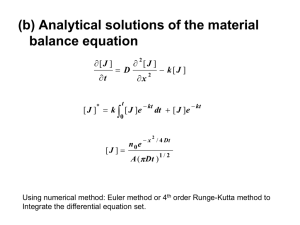
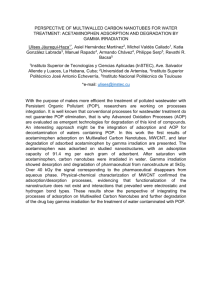
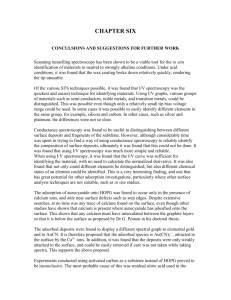
![njc28_publication_7[^]](http://s3.studylib.net/store/data/007444336_1-90bc91a2c5e5c86ca1e693fb6cfd488e-300x300.png)
